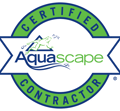Frequently Asked Questions
1. What is an ecosystem pond?
An ecosystem pond is a self-sustaining, balanced aquatic environment that mimics a natural ecosystem. It consists of a pond made of rocks and cobbles, with a variety of aquatic plants, beneficial bacteria and a plethora of wildlife. It utilizes natural filtration methods such as biological filters, skimmers, and waterfalls to maintain water quality. The pond is designed to be low-maintenance and environmentally friendly.
2. What is a Pondless Waterfall?
It is a self-contained water feature that mimics the looks and sounds of a natural waterfall without the need for a pond. It consists of a hidden underground reservoir where the water is collected and then sent up to the top of the waterfalls to create a continuous flow over rocks or other decorative elements, until it disappears into the reservoir again, creating a continuous cycle. It provides the beauty and tranquility of a waterfall without the presence and maintenance of a pond.
7. What type of plants should I have in my ecosystem pond?
A variety of plants can be incorporated into your ecosystem pond. These include marginal plants, such as irises, which grow at the water's edge, submerged plants like oxygenators or water lilies, and floating plants like water hyacinths. Each type of plant serves a specific purpose, such as oxygenating the water, providing shade, and offering habitat for aquatic life.
6. How often should I drain and clean my ecosystem pond?
The frequency of draining and cleaning your ecosystem pond depends on various factors, including its size, stocking density, and environmental conditions. Generally, a thorough cleaning is recommended once a year, where 50% or more of mature pond water is conserved (and fish moved safely if any), and interior is pressure washed. This involves removing excess debris, thinning out plants, and cleaning the filtration system. Regular maintenance tasks, such as removing floating debris, should be performed as needed.
3. How much does it cost to build a pond?
On average, a small sized natural looking ecosystem pond with 1 waterfall may range from ~£5,000 to ~£10,000. This includes the excavation, pond liner, filtration system, rocks, gravel, plants and labour costs. Larger, more elaborate designs with additional features such as waterfalls, streams, larger rocks, illumination, or advanced filtration systems can cost anywhere from ~£15,000 to ~£30,000 or more, based on how many additional features you would like to add.
5. How do I maintain an ecosystem pond?
Proper maintenance is essential for the long-term health and beauty of an ecosystem pond. Here are some key steps to maintain your pond:
1. Regularly empty skimmer basket, remove debris, such as leaves and twigs from the pond.
2. Trim and thin out aquatic plants to maintain a balanced ecosystem.
3. Test the water quality regularly and adjust parameters as necessary with treatments.
4. Clean and maintain the filtration system, including skimmers and filters.
5. Keep an eye out for signs of potential issues, such as excessive algae growth or water loss, and take appropriate action.
Or call us!
8. Can I have fish in my ecosystem pond?
Yes, you can have fish in your ecosystem pond. Fish add beauty and life to the pond, and they also play a role in the ecosystem by controlling algae growth. Common fish species for ponds include koi, goldfish, shubunkins and native fish species.
4. What is the process of installation?
The process of installation for our water features is divided in 5 stages.
Stage 1. Consultation, Planning and Designing.
Stage 2. Preparation and Excavation.
Stage 3. Installation of Components and Rock Placement.
Stage 4. Detailing, Finishing Touches and Clean Up.
Stage 5. Project Presentation.
9. How do I choose the right size of a pond or water feature for my space?
Begin by assessing the available space in your garden, taking into account any existing structures or landscaping elements. Next, determine the purpose and functionality you desire, be it for aesthetic appeal, as a focal point, or to support aquatic life. The chosen size must complement the surrounding landscape, creating a harmonious visual appeal. Additionally, take into consideration the budget you are willing to contribute.
10. How do I prevent/control algae growth in my pond?
To prevent algae growth in your pond, follow these effective strategies:
1. Maintain nutrient balance by avoiding overfeeding your fish, minimizing organic matter accumulation and add beneficial bacteria.
2. Install proper filtration systems for removing excess nutrients and debris.
3. Provide adequate aeration and water circulation with pond aerators or fountains/waterfalls.
4. Incorporate a variety of aquatic plants to compete with algae for nutrients and provide shade.
5. Limit sunlight exposure through the use of water lilies, floating plants, or shading elements.
6. Perform regular maintenance, such as debris removal and manual cleaning.
7. Use treatments sparingly as a last resort.




